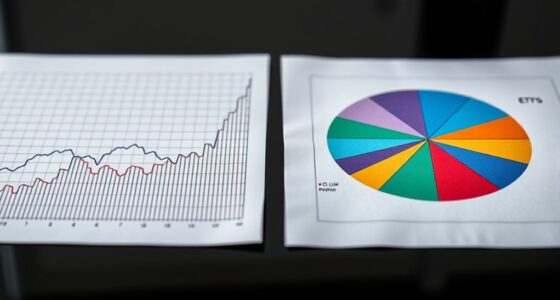Dollar-cost averaging is a simple way to invest regularly by putting the same amount into an asset, no matter what the market does. This approach helps you buy more shares when prices are low and fewer when prices are high, lowering your average cost over time. It reduces the emotional stress of market ups and downs and encourages patience. Keep exploring, and you’ll discover how this strategy can support steady growth and smarter investing habits.
Key Takeaways
- Dollar-cost averaging involves investing a fixed amount regularly, regardless of market prices, to reduce timing risks.
- It helps new investors avoid emotional decisions driven by market fluctuations like fear or greed.
- This strategy purchases more shares when prices are low and fewer when prices are high, lowering average costs over time.
- It encourages disciplined investing and promotes patience, leading to steadier long-term wealth growth.
- Combining dollar-cost averaging with stress-reduction practices can enhance investment experience and confidence.

Dollar-cost averaging is a straightforward investment strategy that involves regularly investing a fixed amount of money into a particular asset, regardless of its price fluctuations. This approach helps you avoid the pitfalls of trying to time the market, which can be tempting but often leads to costly mistakes. Instead of worrying about whether prices are high or low at any given moment, you commit to consistent investing over time. This discipline reduces the emotional stress that can influence investment decisions, making it easier to stay on track even when markets are volatile.
Dollar-cost averaging involves consistent, fixed investments to reduce market timing risks and emotional decision-making.
When you use dollar-cost averaging, you’re not attempting to predict market movements; you’re accepting that prices will fluctuate. By investing the same amount regularly, you’ll buy more shares when prices are low and fewer when prices are high. Over time, this can lower your average cost per share and help smooth out the ups and downs of the market. This method can be especially advantageous for new investors who might feel overwhelmed by market timing strategies that rely on predicting future price movements. Instead of trying to outsmart the market, you’re focusing on consistency, which often proves more reliable in the long run.
Market timing is notoriously difficult because it requires accurately predicting short-term market moves—something even professional investors struggle with. Many new investors fall into the trap of emotional investment psychology, where fear and greed drive their decisions. When markets fall, they might panic and sell, locking in losses. Conversely, when markets rise, they may become overly optimistic and buy at peak prices. Dollar-cost averaging helps you bypass these emotional swings by sticking to a predetermined plan. It encourages a rational, disciplined approach, reducing the influence of investment psychology that can lead to impulsive moves.
Furthermore, dollar-cost averaging aligns with a long-term investment mindset. It helps you avoid the temptation to chase after quick gains or attempt to predict market peaks and troughs. Instead, it promotes patience and consistency, which are key to building wealth over time. Additionally, incorporating essential oils like lavender or eucalyptus can help reduce stress and promote a calmer outlook during volatile periods, supporting your disciplined investing approach. This strategy can make investing feel less stressful because you’re not constantly second-guessing your decisions based on market noise. Instead, you focus on your plan and let the power of regular investing work in your favor.
In essence, dollar-cost averaging is a simple yet powerful tool for new investors. It minimizes the risks associated with market timing and helps you overcome common psychological hurdles. By committing to regular investments regardless of market conditions, you create a disciplined habit that can lead to more stable growth and a healthier investment experience.
Frequently Asked Questions
How Does Dollar-Cost Averaging Compare to Lump-Sum Investing?
When comparing dollar-cost averaging to lump-sum investing, you focus on investment timing and market risk. Dollar-cost averaging spreads out your investments over time, reducing the impact of market fluctuations and lowering your risk during volatile periods. In contrast, lump-sum investing puts all your money in at once, which can lead to higher gains if the market rises but also exposes you to greater risk if it drops quickly.
Can Dollar-Cost Averaging Be Used With Cryptocurrencies?
Cryptocurrency consumers can definitely deploy dollar-cost averaging to diminish risks and deepen understanding. By steadily purchasing cryptocurrencies, you capitalize on fluctuating prices, smoothing out volatility. As blockchain technology advances and cryptocurrency adoption accelerates, this method helps you stay consistent and confident amid market swings. You’ll build your portfolio gradually, gaining exposure without trying to time the market perfectly—making dollar-cost averaging a practical, persistent strategy in the dynamic digital currency domain.
What Are the Tax Implications of Dollar-Cost Averaging?
When you use dollar-cost averaging, you should consider the tax implications, especially regarding capital gains. Each time you buy or sell, you might trigger taxable events, which could lead to paying capital gains taxes. It’s important to track your transactions carefully and understand how holding periods affect your tax rate. Consulting a tax professional helps ensure you manage your investments efficiently and stay compliant with tax laws.
How Do Market Volatility and Timing Affect Dollar-Cost Averaging?
Market fluctuations and investment timing influence your dollar-cost averaging strategy substantially. During periods of high volatility, you buy more shares when prices dip, which can lower your average cost. Conversely, in stable markets, your purchases might be more consistent but less advantageous. Timing matters because spreading investments over time helps you avoid trying to predict market peaks or troughs, reducing risk and smoothing out the effects of market fluctuations.
Is Dollar-Cost Averaging Suitable for All Investment Types?
Like the steady hand of a seasoned sailor, dollar-cost averaging suits many investment types by offering risk management through consistent investing. You can apply it to stocks, ETFs, and mutual funds, but it’s less effective for assets with high volatility or speculative investments. While it helps reduce timing risks, you should consider your specific investment goals and risk appetite to guarantee it aligns with your overall strategy.
Conclusion
By consistently investing with dollar-cost averaging, you reduce the impact of market volatility and build your wealth steadily. Did you know that investors using this strategy tend to see fewer emotional decisions and better long-term results? It’s a smart way to stay disciplined and avoid trying to time the market. So, keep investing regularly, stay patient, and watch your investments grow over time. Your future self will thank you for it.









